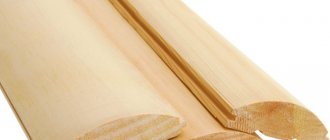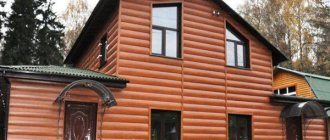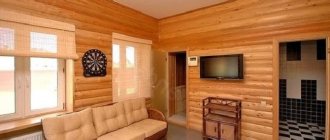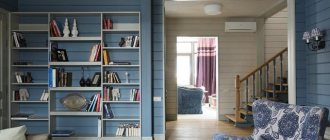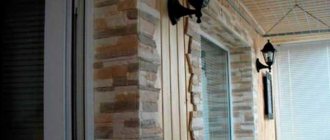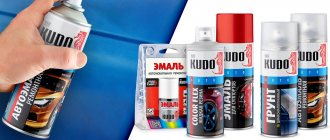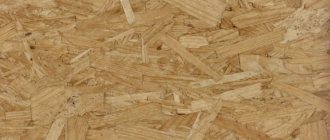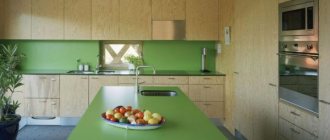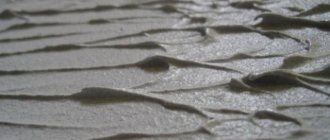How to paint a block house - features, treatment.
It is no secret that making houses from wood is not just beautiful and tasteful, houses made of wood also retain heat, allow air to pass through well and provide an optimal level of moisture. Wooden buildings are becoming more and more popular every year due to its environmental properties. However, owning such a house is not so easy: you need to know how to properly protect the house from various insects, from fungal infections, and simply how to maintain its original appearance for as long as possible. Before choosing how to paint a block house, first of all you need to pay special attention to what type of wood your house is made of, because the wrong material can simply ruin not only the appearance of the block house, but also shorten its lifespan by several years.
To care for a block house, various decorative solutions with protective properties are used.
Do I need to paint the block house?
Houses made from this material have many advantages, due to which they become popular. The block house has an attractive, aesthetic appearance.
Natural wood, which is the basis for finishing, must be protected from the appearance of fungus and attacks by wood parasites. Impregnation or other special compounds will extend the life of natural wood.
Imitation of a log house
Block house is a modern finishing material made from high quality natural wood.
The structure of the block house panel follows the contours of a rounded log. Compared to analogues, this material is more popular. It is applicable for both external and internal finishing of buildings and structures for various purposes. For the manufacture of block house panels, northern species of coniferous trees such as cedar, larch or pine are used, but other options are possible, which may vary depending on the region. The service life of the panels depends on the type of wood, the conditions of its use and processing.
Required tools and materials
Before processing, you will need to level the surface, remove nails, remove joints and chips. To do this you will need to stock up on primer. If this is not done, after some time traces of rust may appear on the surface, which will certainly spoil the appearance.
To apply impregnations and paints, you will need to prepare a roller or a special spray bottle.
It is better to paint all joints and seams with a brush, but this should only be done in the longitudinal direction.
For preliminary preparation of natural wood, you will need brushes with hard bristles.
To effectively paint the end sections and reliably protect the surface from damage and harmful environmental factors, special sealants will be required.
To cover or not to cover?
The price of a blockhouse depends not only on the species and type of wood. By purchasing beautiful and inexpensive material at the nearest sawmill, a happy buyer will most likely pay extra for the savings a little later, choosing compounds to protect it. The more expensive, factory-made version of the house block is often sold with protective impregnation, which not only frees the owner from headaches in the first years, but also significantly improves the physical properties of the material.
Industrial impregnation of a house block is carried out using unusual brushes and spray guns. The material is placed in an autoclave, where first the residual moisture is extracted from the capillaries of the wood by vacuum, then an antiseptic composition is injected under pressure, impregnating the wood to a certain depth, after which the excess liquid is sucked out again and the wood is dried. This processing method allows the structure of the material to be etched almost entirely, which is why even the cheapest and softest types of wood acquire premium qualities. Factory treatment will provide the blockhouse façade with several years of protection without additional measures.
How to prepare the surface?
Is it necessary to paint a block house and how to make high-quality preparation for work? Before treating the surface, thoroughly clean it from dust, dirt and remnants of old materials. The process is carried out with special steel brushes or a grinder.
If there are areas with mold on the facade of a block house, it must be thoroughly cleaned and then treated with bleaching agents. For this purpose, special stains for lightening are offered.
Rollers and brushes are used to apply the final coating. The brush provides precise access to hard-to-reach areas. But painting with a roller or spray is much easier and faster.
How to paint imitation timber
Imitation timber is a technologically advanced profiled lumber intended for cladding walls on the facade or inside a house. It is usually considered as an alternative to eurolining or compared when choosing with imitation logs (blockhouse). It also has a very accurate, repeatable geometry and an initially well-thought-out section; it goes through the stage of chamber drying of the workpieces and high-quality planing/milling of surfaces. There is a reliable tongue-and-groove connection, ventilation grooves on the back surface and, of course, a stylish appearance of the finished skin.
In Moscow, imitation timber is mainly made from spruce or pine. And to order, they will cut you material from oak, beech or linden... however, it will cost a little differently. Products made from pine needles normally serve for decades, they are beautiful in themselves, although the boards can be tinted to match something more “solid”. Whatever type of wood is used to make imitation timber, the sheathing must be processed.
Installation of a house made of imitation timber
Installation of a house made of imitation timber
Transparent compounds
Protective transparent azures, varnishes, are a solution that will not only preserve the finishing material for a long time, but also preserve the natural appearance of a wooden block house. Products without color can be used to treat a block house not only outside the house, but also inside.
When working indoors, it is recommended to apply 2 times less layer of varnish.
Impregnation
To eliminate parasites, mold and other unpleasant phenomena, impregnations are the most effective. According to classification they are offered:
- Oil based (based on linseed oil).
- Acrylic water soluble.
- Alkyd (with alkyd resins).
Transparent impregnations have the following characteristics:
- Antiseptic.
- Fire retardant.
- Bioprotective.
These properties provide the following characteristics:
- Protection of the block house from mold and mildew, damage by harmful insects.
- Prevents the appearance of darkening and blue areas.
- Reduces the formation of chips and cracks on the surface.
- Increase the period of operation.
In addition, transparent impregnations are a universal base for decorative painting.
Stains and varnishes
If you need to paint natural wood, so as not to distort the natural color and pattern, special stains and varnishes are offered. The composition of these products effectively protects the block house and preserves its naturalness.
When dealing with the issue of painting a block house, you must adhere to the following recommendations:
- Before carrying out the procedure, the surface must be prepared, cleaned of dust, and if necessary, dried.
- Prepare in advance a foam roller or brush for painting the house block.
- Initially, you need to apply a thin layer of tinting product.
- For the first layer of indoor treatment, it is recommended to use one-component stains or varnishes.
- Indoors, for high-quality protection, only 2 layers of a transparent product will be enough.
- For exterior work, two-component house block paint should be used.
- The exterior of the building is treated with a double layer of varnish.
Lazuri
The peculiarity of using azure is that it is a universal product that combines the features of impregnations and the advantages of varnishes. Lazuries are also called glazing agents.
Thanks to their combined properties, glazes simultaneously take good care of the wood and give an interesting, sophisticated appearance to the surface.
The assortment includes the following glaze compositions:
- Tinted.
- Alkyd.
- Alkyd oil.
- Alkyd-urethane.
- Matte.
- Glossy.
To add texture to the surface of the house block, glazes are used, which allow the natural material to be tinted in any shade.
For protection you will need at least 3 layers of the composition, which can be conveniently applied with foam rollers or oil brushes. Sprayers can be used for processing, but this requires some experience. If you don’t have the skills, it’s better to use the services of specialists; the price of the work will depend on the area of processing.
The undoubted advantage of azure is the combination of high quality, affordable cost and the ability to extend the service life of the block house for a long time.
Deep impregnation
Modern manufacturers, to increase the service life of a block house, often use all kinds of antiseptic impregnations that perfectly protect natural wood from rotting, fire and biological factors (wood-boring insects). Special chemical protection agents, called anti-frozen agents, can significantly increase the fire resistance of a blockhouse.
In order for block house processing to be most effective, special autoclaves are used in industrial production. Processing the material according to the “vacuum-pressure” scheme allows impregnating chemical compositions to penetrate most deeply into solid wood, with further distribution throughout the thickness. As a result, even inexpensive species (pine and spruce) acquire all the performance properties of hardwood.
Surfaces with any geometric cross-section can be impregnated (sawn timber, round logs, blockhouse). Some wood defects (tarting, browning, false heartwood) make processing difficult. The bark along with the bast must be removed from the logs.
An autoclave or pressure chamber is a sealed vessel. Processing of a block house occurs in several stages:
- before processing the blockhouse, residual moisture and air from the wood capillaries are additionally removed from it in a pressure chamber under an initial vacuum;
- after this, a reagent for processing is pumped into the pressure chamber;
- under the influence of hydraulic pressure, the wood is impregnated with a protective composition. Processing time and parameters depend on the type of wood. Aging of coniferous species (larch, spruce or fir) lasts 400 minutes, and for birch 195-200 minutes are enough. In addition, the part of the trunk from which the blockhouse is made is of considerable importance. The peripheral wood (sapwood) is easily permeable to the preservative, but the central part (core) is much more difficult to impregnate. The depth of impregnation is regulated by GOST 20022.0 -93 and is 5 mm for cedar, 2 mm for other conifers;
- after the end of exposure in the solution, excess chemical is pumped out and the wood is again subjected to vacuum to remove surface moisture;
- The final stage of processing is holding the material at atmospheric pressure to fix the preservative liquid.
Such deep treatment with fire retardants and biopyrenes will be much more effective than covering a blockhouse at home and allows not only to protect the wood as much as possible from rotting, but also to give it a certain fire resistance. If you purchased a blockhouse without treatment, then you can improve its properties yourself.
Block house from the manufacturer, used cutters and machine
Opaque formulations
To stylize the appearance of the building’s façade and to give the interior a certain “zest,” you can use textured opaque compounds.
Water-soluble paints
When treating the surface of a block house, water-soluble compositions can give it the following colors and shades:
- Nut.
- Oak.
- Ripe cherry.
- Red tree.
- Maple.
- Lemon.
Water-soluble compositions are not as durable as analogue paints or varnishes, but they are much more environmentally friendly and safer. Due to this, water-soluble paints are preferred for indoor use.
Organic solvent based paints
Protective compounds developed on the basis of organic solvents can be of the following types:
- Acrylic.
- Alkyd.
- Polyurethane.
- Enamel.
- Oily.
Paints based on organic bases differ from analogue offerings in their high quality of coating. It is very convenient to work with them inside the house, for example, on the balcony, in living rooms.
But, despite this, paints based on organic solvents erase the natural imitation of wood, and the individual feature of the block house is lost.
Types of lining coverings
As already mentioned, there are two types of lining - wooden and plastic. It is clear that wood is much more environmentally friendly and beautiful, and, of course, costs more (like any natural material). But in some cases it is better to use plastic panels. For example, when there is high humidity in the room or for finishing external facades.
This finishing material can take different forms:
- A panel that imitates a block of wood. Moreover, most often this is what the plastic variety looks like.
- Eurolining stands out from the general mass by longitudinal grooves on the underside of the board, which are used for drainage of moisture and ventilation of fumes. This is a very high quality wood panel that is used to cover the facades of houses.
- The block house is distinguished by a convex texture that imitates a wooden frame. But its inner side is flat, has grooves with spikes on the sides. This lining can be made of either wood or plastic.
- The American imitates wooden planks laid out overlapping. It is usually made of wood, although now there is an American one made of plastic. This variety is used for exterior decoration.
Despite the almost identical texture, such panels can be attached to the surface in different ways.
Russian, Finnish and Swedish folk remedies
Different countries have their own characteristics of construction and subsequent maintenance of buildings. Folk recipes for processing block house have proven reliability over hundreds of years.
Russian recipe
In Russia, wooden houses have been built for many centuries, so over the years, many effective and simple recipes for caring for wood have accumulated in the arsenal.
The walls of houses are covered with lime-based products, and clay compositions are also used.
The clay-salt-water solution is very popular. It is suitable for processing wooden surfaces:
- Prepare the ingredients clay, salt and water.
- For the solution, take 74 parts clay, 4 parts salt.
- Add water in such quantity to obtain the consistency of thick sour cream.
After this, brush the block house with a thin layer, wait until it dries completely, apply the 2nd layer.
Finnish recipe
The Finns do not lag behind in house construction methods; they also have high-quality and reliable methods of caring for natural wood. One of these recipes:
- Combine 720 g of rye flour and 1.5 kg of iron sulfate in one container.
- Add 360 g of kitchen coarse salt and 1.5 kg of dry lime to the mixture.
- Dilute the resulting dry mixture in 6 liters of water.
- Strain and put the mixture on low heat.
- Bring to a boil and stir constantly to form a creamy paste.
- Boil 3 liters of water and carefully add to the paste.
The consumption of the protective mixture is 300 g per 1 sq.m.
The Finns also offer a variety of high-quality and effective ready-made compositions, for example, Tikkurila varnishes or the glazing antiseptic composition Valti Color Satin.
Processing during construction
If the Block House, which you are going to use for facade or interior finishing work, has not been processed in the factory, then you need to decide how to cover the Block House outside the house and indoors.
To protect wooden structures during construction and operation, impregnations, varnishes, glazes, drying oils, paints and stains are used. Let's look at those that are recommended for covering a Block House.
Advice! When choosing wood impregnation, remember that its shelf life is limited, check the date of manufacture.
Impregnations
Properly selected and applied impregnation for the Block House will preserve the performance and appearance of the house facade for a long time.
Impregnations are made on various bases:
- acrylic water-soluble compounds, which cover fresh, untreated wood, do not have a strong odor, can be used to protect the Block House indoors;
- alkyd compositions - impregnations based on alkyd resins, create durable and high-quality protection for wood coatings;
- Oil impregnations are produced on the basis of linseed oil and are used for impregnation of the Block House on the facade of the building.
Impregnation for wood with biocidal additives and linseed oil.
Advice! If you want to emphasize the texture of wood, then the impregnation should include oils and tinting.
Lazuri
Azure forms a thin moisture-proof film on the surface of the Block House.
It happens:
- transparent;
- decorative, imitating shades of various types of wood.
Glaze differs from varnishes and paints in that, like impregnation, it penetrates into the depths of the wood, emphasizing its noble texture.
A varied range of colors and many shades of azure allow it to be used for processing wooden products instead of the usual acrylic or oil paints.
With the advent of azures on the building materials market, the question of how to treat the Block House, giving the facade an expressive appearance, while protecting it from ultraviolet rays and the harmful effects of weather phenomena, disappeared.
Lazuli, depending on the original components, are divided into:
- alkyd;
- alkyd oil;
- acrylic-oil;
- alkyd-urethane.
The latter contains alkyd-urethane resin, which can give the Block House additional resistance to mechanical damage. This type of glaze is recommended for painting the Block House, both indoors and on the façade of the building.
Water-repellent glaze to protect wood.
Paints and varnishes
When covering the surface of the Block House with varnish or paint, the consumer creates additional maintenance and operation work for himself in the future.
The fact is that these materials cover the wood with a thick film, which over time can crack and peel. And the instructions for applying varnish over an old coating require that the coating be completely cleaned.
For better adhesion of the facade paint layer to the wood, it is necessary to use a primer.
Wax
Wood wax for interior work.
When deciding how to cover the Block House inside the house, focus your attention on the traditional material - wood wax. It creates a water-repellent, light-resistant surface with a noble matte shine.
You can do the waxing of the Block House in the interior with your own hands. This process is not very complicated, and is quite within the capabilities of any hardworking person.
Options, methods and stylistic directions when used in the interior
Block house is a universal material, which allows it to be used not only for cladding facades, but also for interior work. With its help you can create a country, loft, Provence style, or in combination with other materials - modern.
It is not at all necessary to sheathe the entire room with a block house. It can be combined with different surfaces (tiles, stone, brick, plastic). It can be combined with other wooden textures, carpets, and glass elements. For example, when lining a corridor, a block house combines well with lining, and there is a spectacular alternation of lines and reliefs.
This material can be used to cover and decorate rooms such as a bathhouse, bathroom or sauna, and can be used in a library, living room, personal office, bedroom, kitchen, fireplace or billiard room. Some apartment owners use the material to create furnishings in the “Russian hut” style.



